Key filmmakers: Robert Drew, Richard Leacock, D.A. Pennebaker, Albert Maysles, David Maysles
Key dates: 1958-1962
What is it? Mirroring similar movements in France and Canada, the US Direct Cinema movement saw Life magazine journalist Robert Drew import ideas around photojournalism into cinema. Forming The Drew Associates with Richard Leacock, D.A. Pennebaker, Albert Maysles, David Maysles, the group made a trio of politically charged documentaries — best of the bunch: Primary about the 1960 Presidential campaign — that sought to record the action without interference. Critical in this respect was the advent of lightweight portable cameras (chiefly the Arriflex) and the development of synchronous sound (chiefly the Nagra) that allowed a small team of filmmakers to move quickly. “My goal was to capture life in the raw,” said Drew. “My idea was to have one or two people, unobtrusive, capturing the moment.”
Direct Cinema is often described as the US equivalent of the French movement known as Cinéma Vérité. While the 1960 French film Chronicle Of A Summer is an important stepping stone towards Direct Cinema, the two terms are not inter-changeable. Both involve hand-held imagery, the sense of real life unfolding and an interest in social themes but Cinéma Vérité sees the filmmaker interact with the subject whereas the goal of Direct Cinema is to be completely unobtrusive, the presence of the camera not altering the outcome of events.
What to watch: Primary (1960), Crisis: Behind A Presidential Commitment (1963), The Chair (1963), Don’t Look Back (1967) (pictured top), Gimme Shelter (1970)
What did it influence? Direct Cinema was a key progenitor of the fly-on-the-wall format that has dominated documentary — particularly on British TV — for years (although Direct Cinema is without commentary or talking heads). The shaky camerawork, long takes, lo-tech feel and over-exposed stock have creeped into mainstream fiction, from the found footage horror of The Blair Witch Project and Cloverfield to the faux documentary comedy of The Office and Curb Your Enthusiasm.
Trivia: Documentarian D.A. Pennebaker is a distant relative of Marlon Brando. Brando was also the star of the Maysles brothers documentary Meeting Marlon Brando.
What to say: “The Hollywood film is an escape of one sort or another. But our films make it damn near impossible to escape. We’re interested in what you can’t escape from and presenting it” (Albert Maysles)
What not to say: “Is it a bit like TOWIE?”
